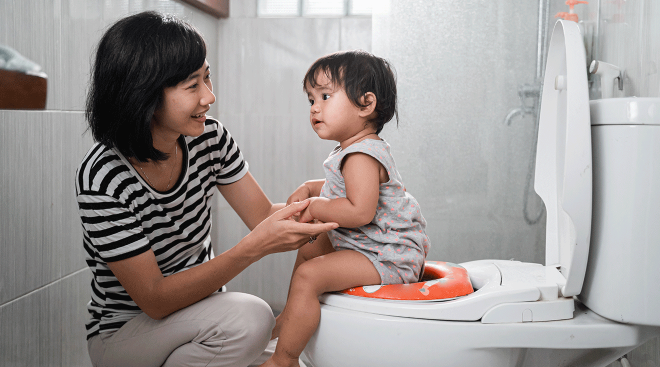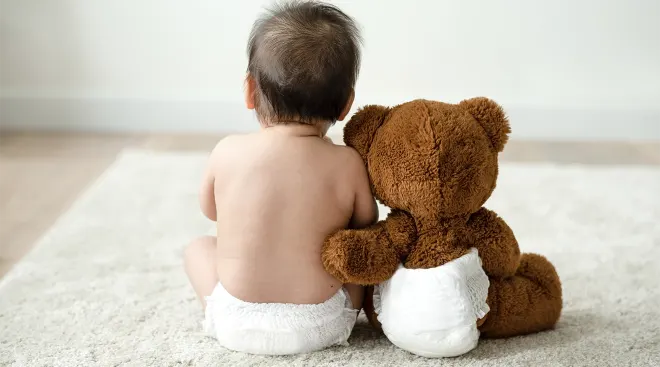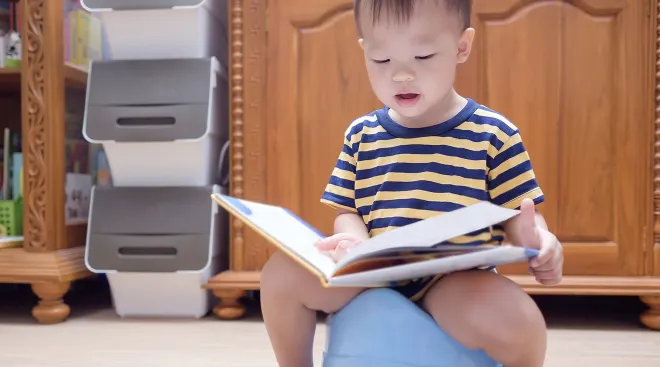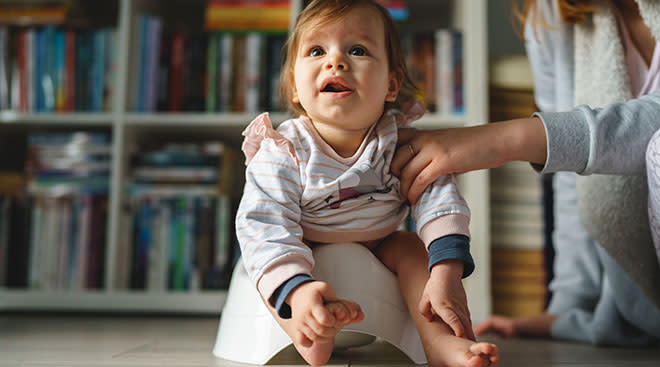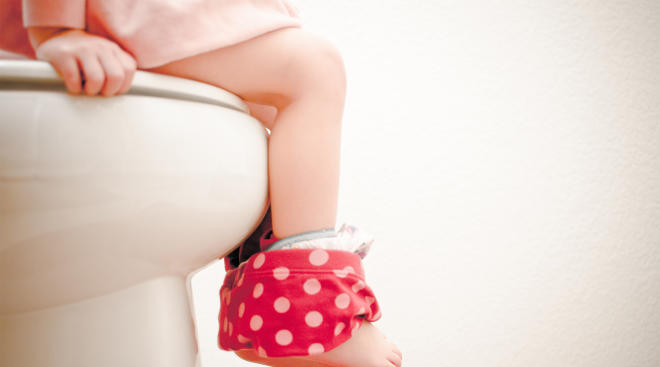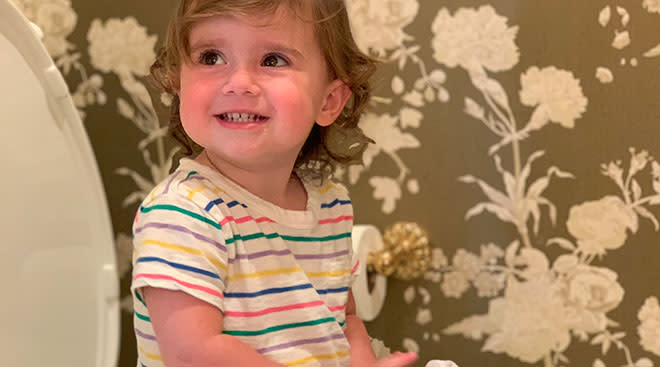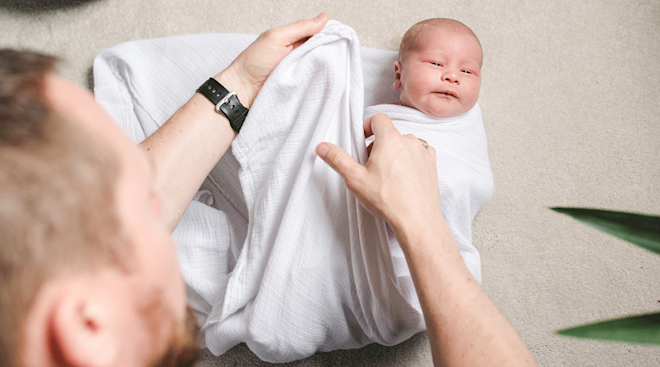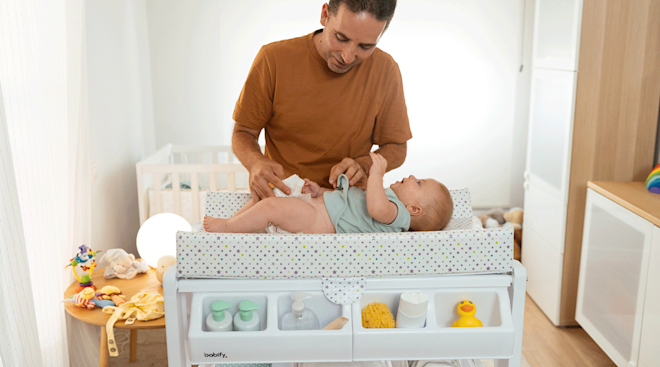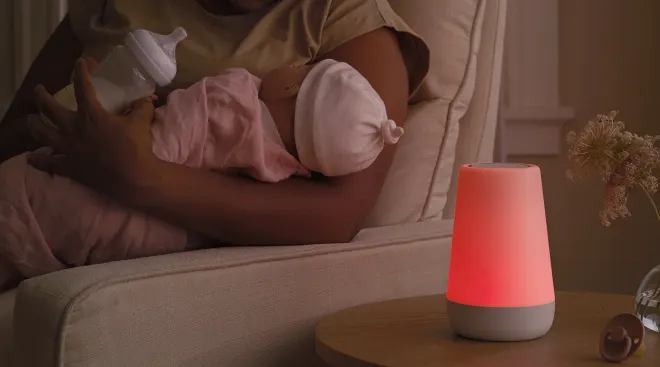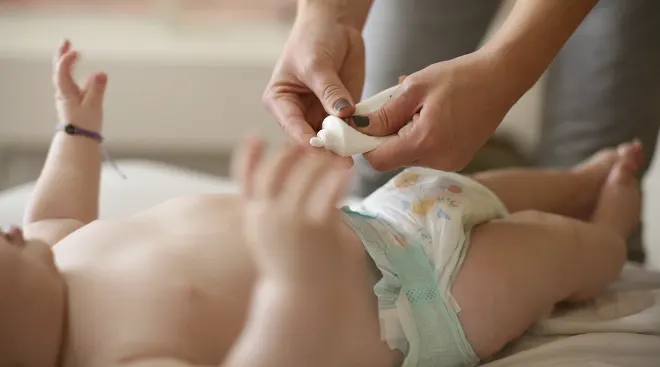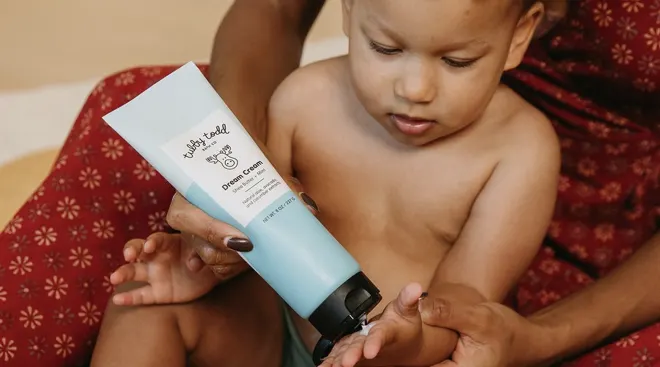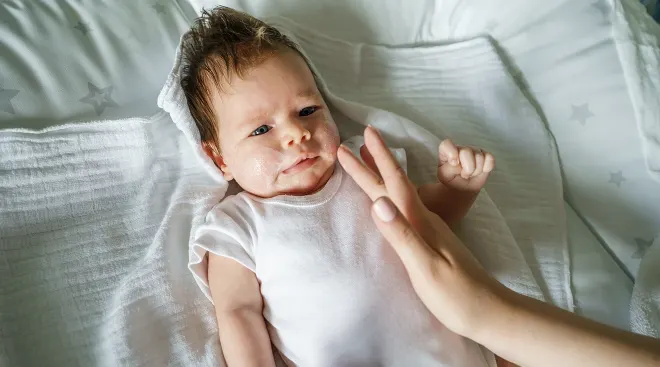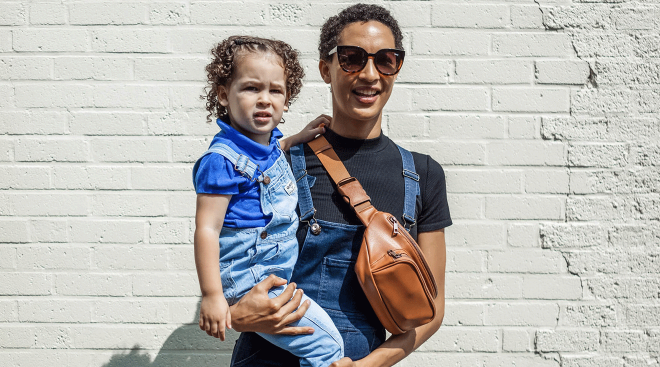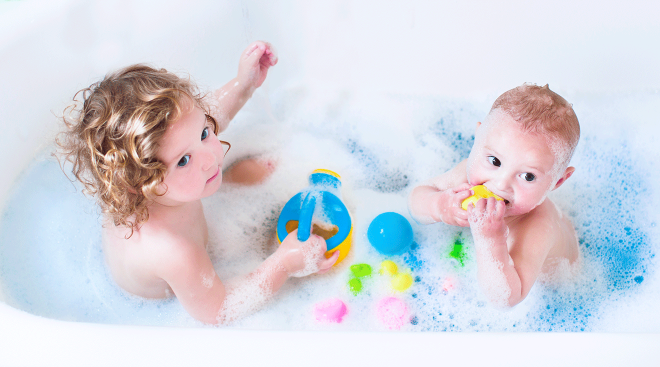Potty Training: How to Get Started—and Making It Work
It may feel like just yesterday that you were changing baby’s first diaper, and in the blink of an eye you’ve reached the mother of all milestones: potty training! It may be difficult at times, but you can find comfort in the fact that all parents go through this. While the end goal is always the same—ditching those diapers, and ushering in the era of underpants—it’s not a one-size-fits-all process. Stressing over how to potty train your tot? Don’t. Whether you’re potty training boys or girls, we’ve got everything you need to know—including when to start potty training, common potty training problems, the best potty training tips and everything in between. Ready? Set up that baby potty and start here.
The first question that often comes to parents’ mind when thinking about potty training is when to start. While there’s a general age range for when toddlers are developmentally ready to potty train (more on this below), it’s something every child will do at their own pace. While you may be ready to start potty training your child, they may not be ready to enter the toilet trenches. “It’s important to be patient and not feel like you have to rush it,” says Lee Beers, MD, the medical director for Municipal and Regional Affairs at the Children’s National Health System. “Feeling pressured to toilet train makes it a more negative experience for both the child and the parent.”
The best potty training age
According to the American Academy of Pediatrics (AAP), neurotypical kids are physiologically ready to start potty training at 18 months. This is because their digestive system and bladder are mature enough to know when to “hold it” long enough to get to the potty. However, realistically, a child may not be ready to train until 24 months.
While many toddlers will be ready between 18 and 24 months, some children will be willing to potty train earlier and some might not be prepared to learn until closer to 36 to 42 months. (It may also take that long for a potty trained child to stay dry during the day and at night.) Instead of going by age, Mark L. Wolraich, MD, a pediatrician and professor of pediatrics at University of Oklahoma Health Sciences Center, says parents should look for potty training readiness signs. “If these [signs] aren’t happening yet, wait a little while until they do, because that can make the process much smoother,” he says.
Potty training readiness signs
To see if your toddler is up for the task of potty training, look for some key indicators. Allison Jandu, owner and founder of Potty Training Consultant, breaks the signs up into two categories: developmental—such as communication and fine motor skills—and “potty-related”—such as an interest in the bathroom, asking for diaper changes and staying dry for longer periods of time. Below, a few signs your child is ready to potty train. “Children may exhibit one or all of these signs,” Jandu says. “There is no ‘normal’ and every child is different.”
-
Pulling at a wet or dirty diaper. There comes a point when kids don’t like to sit in dirty diapers. This means they may let you know as soon as the diaper is wet or dirty and ask to be changed. When they start the diaper tug-of-war, that could be their way of telling you they’re ready to learn how to potty train.
-
Interest in other people going to the bathroom. We all know kids mimic what they see and hear. An interest in other people’s potty habits could be a sign they’re ready to start forming their own. Plus, if that colorful little potty chair that’s been sitting in the corner is finally of interest to your child, that’s a great sign.
-
Dressing and undressing themselves. Part of being potty trained is being able to pull your pants up and down. If your child can do this, they could soon have a date with the potty.
-
Understanding and following basic directions. If you notice your kiddo can understand and follow your direction, then you may want to start potty training.
-
Staying dry for two hours or more. When you start noticing dry diapers after a nap or a couple of hours around the house, this is another sign your child is ready to potty train.
-
Tells you when they have to go. This could be verbally or through unique facial expressions that come along with the sensation of needing to pee or poop.
Signs your child is not ready for potty training
Of course, alongside potty training readiness signs, there are also some indications your child may not be quite ready to potty train. Jandu says parents should watch out for the following signals:
- Your child is unable to stay dry for extended periods of time (i.e. an hour or more).
- Your child is still having bowel movements during sleep.
- Your child has a genuine fear of the toilet and is afraid to use the bathroom without a diaper on.
- Your child starts to withhold pee and poop for a long amount of time, to the point where it’s uncomfortable.
“[These] are all red flags that it’s time to step back and give them some more time before revisiting,” Jandu explains. She adds potty training can also be challenging (but not impossible!) without basic communication skills and gross motor skills, such as sitting, standing and walking.
One you’ve spotted readiness signs in your child, prepare to start potty training. It’s important to remember that both you and your child need to be ready to start the process. “Potty training will be most successful when everyone is feeling confident and committed,” Jandu says.
Tips for preparing to potty train
Perhaps the most important thing to remember when potty training is to make the process upbeat and conflict-free. Use as much cheer and positive reinforcement as possible to avoid potential potty training problems. To start out on the right note, here are a few universally helpful potty training tips to keep in mind as you go:
Time it right
Think about what’s going on in your family. Are changes on the way? If you’re about to move, have a new baby or your child is starting a new school, for example, consider waiting a bit. These are all big changes for a child (heck, for anyone!) to deal with, and adding potty training to the mix is a bit too much to take on at the same time, Jandu says.
Grin and “bare” it
To help your child become more aware of their body’s signals, you may want to let them walk around naked from the waist down during the first few days of potty training at home. (Besides, it’s hard to ignore a trickle of urine running down your leg.) Of course, keep an eye on your child for those telltale signs they have to pee or poop, and have a potty within easy reach so you can rush them over when it’s go time.
Dress for success
Speed is key in avoiding accidents, so when the time comes to hustle to the potty, you don’t want any extra struggling involved. Avoid pants with buttons or clasps that are tricky for small fingers, or tights and skirts, since that combo can be tougher to manage than just stretchy leggings. Keep it simple for everyone while you’re in the middle of potty training and stick with easy-on, easy-off elastic-waist pants.
Get the gear
You don’t have to buy every product on the market, but reading some fun potty training books together can be an easy start, and you can even involve your child in choosing a mini potty or seat topper for the adult toilet. Letting them pick out their own character underwear is another great way to get your kiddo excited to potty train. After you get the gear, tell your child when you go to the bathroom and show them it’s part of the normal daily routine.
Offer up plenty of praise
Whether your child has successfully made it to the potty in time or they’re just starting to give you a heads up when they feel the need to go, it’s a reason for a mini celebration. Hugs and kisses and silly songs are all great ways to encourage and make your child feel proud of their accomplishment. For some children, it also helps to remind them of all the ways that potty training is awesome. That may mean talking more about what it means to be a “big kid” or using a fun sticker chart to track progress.
Decide on potty training rewards
Many experts and parents find that offering rewards or treats works effectively in potty training—but not always. “Giving rewards is a family’s personal choice, based on their parenting preferences and philosophies,” says Michelle Swaney, CEO of The Potty School. There are pros and cons to this practice. While offering potty training rewards—like high-fives or stickers—can help parents celebrate successful potty trips with their child in a tangible way, it may also lead to the child expecting a reward every time they use the bathroom. Wolraich agrees, adding that parents should also steer clear of bribery. After all, children should learn to use the potty on their own terms because they have the desire to use it, not just because they think there will be a treat waiting for them every time. “You have to think long term, not short term,” Wolraich says. To avoid this dependency, if you offer rewards, do so for a short, set amount of time rather than indefinitely. During this time, make sure to offer rewards for all good behavior during potty training, so you don’t draw too much attention to potty accidents, Jandu adds.
Hit the bathroom before bed
Nighttime potty training can take a little longer, so expect more accidents in this department. To minimize the number of sheet changes, have your child go to the bathroom right before they hit the sack. Do the same before nap time. And, if possible, try to limit their fluid intake after dinner.
Be patient and avoid negative language
Keep your expectations realistic and don’t count on perfection—kids don’t often suddenly wake up one day 100 percent potty trained. Even when you think you’re at the finish line, potty training resistance can rear its head and accidents will most likely happen. When they do, don’t punish or use harsh words. Sure, you may be disappointed—or even steaming mad, depending on where the accident happened—but losing your cool can discourage your child, make them feel ashamed or angry and only bring about more resistance. Plus, children can pick up on any tension they feel coming off of you. Toddlers at this age are often looking for ways to test their limits, and for some, this means holding back bowel movements. “Try to stay calm about toilet training. Remember that no one can control when and where a child urinates or has a bowel movement except the child,” Wolraich says.
Potty training methods parents swear by
There are several different ways to do it: using training pants, going straight to underwear, going naked from the waist down, or doing it in three days, three weeks or three months. One particular way isn’t going to work for every child, and you may even need to mix and match methods to get the results you want. But whatever you choose, odds are you’ll hear of someone else who used a different potty training method and swears it was the best way to do it. Remember: Like with so many other parenting choices you have to make, you’ll need to decide what works best for your family. Here are some potty training methods you can try:
The one-day method
The one-day potty training method is based on a book by Teri Crane. It involves a self-wetting doll that demonstrates going to the bathroom for little ones and a “Potty Party” that kicks off the process. Make it clear that starting from this day on, your child will be graduating to underwear and the potty will be the place to go to do their business. For this method, first show your child how the doll uses the potty, celebrating and praising the doll when it goes on the potty correctly. Then guide your child in the same way with equally excited celebrations and praise for their triumphs, as well as positive directions for any accidents. You may opt to let your child go bare-bottomed the whole day to make the process easier. (This also makes it messier, so keep your cleaning supplies handy!) Encourage your child to drink more than usual that day and then lead them to the potty multiple times throughout the day to remind them that they might have to go.
Some call it the boot camp of potty training, but this one’s pretty similar to the one-day method. The three-day method requires a bit more time staying home near the potty, but it employs all the same praise and positive reinforcement. Before starting, have a potty training talk and explain to your child that they need to tell you when they have to go potty. Advocates of the three-day potty training method say by having your child tell you when they have to go, you’re giving them a sense of control, which helps with potty training. During all three days, be consistent and follow the same rules. Those who’ve found success with this method say it gets better each day!
The “Oh Crap Potty Training” method
The Oh Crap Potty Training method is based on a book written by Jamie Glowacki. This method follows six “blocks,” or stages: using the potty naked at home; wearing pants but not underwear to use the bathroom; leaving the house and potty training on the go; potty training with underwear and pants; cutting back on reminders to use the potty; and, lastly, nighttime and naptime potty training. While the method follows blocks instead of a period of time, Glowacki states the method usually takes anywhere from three to seven days for neurotypical children.
The pull-ups method
Many parents don’t go straight from diapers to underpants, but instead make the transition in steps, like switching from diapers to Pull-Up diapers. They’re similar to diapers but much easier to get on and off when your child is practicing sitting on the potty with a bare bottom. Plus, when accidents happen, you can just rip them off and toss them away like you would with a regular diaper. Some parents also prefer using potty training pants as an in-between step. These are generally a bit thicker than underwear, so they can contain accidents better, but they aren’t so absorbent that your child doesn’t get the immediate feedback of feeling wet or soiled.
The Montessori potty training method
The Montessori method uses the phrase “toilet learning” instead of potty training and actually starts much earlier than the toddler years. For this method, parents are encouraged to talk to baby about their diaper using phrases such as “you’re wet” or “the diaper is full” during diaper changes. This helps children understand how to communicate their toilet needs as they get older. While many of the functionalities of the Montessori potty training method are similar to others, it places an emphasis on allowing children independence as they learn this new skill.
Elimination communication is much different than other methods of potty training because it starts when the child is still an infant. The method involves parents learning their child’s natural signals for when they have to use the bathroom. Once they learn these patterns, parents place baby on the potty when they have to go. The goal behind this method is to pick up on baby’s elimination pattern rather than assuming baby pees and poops at random times.
Regardless of which method you choose, there are a few basic potty training steps you’ll want to follow:
Step 1: Stock up on any necessary gear, depending on the method you’ve chosen (think: a potty seat, children’s books about potty training, elasticized pants, Pull-Ups, etc.)
Step 2: Pick a start date and stick to it.
Step 3: Be consistent and follow your chosen method. Potty training a little one is no easy task, but keep at your potty training schedule.
Step 4: Give your method as much time as is outlined. You may face some challenges as you move along, but if your child is displaying potty training readiness signs, don’t give up before letting the allotted time for your method pass.
Step 5: Be patient and compassionate. Even after a child is potty trained, accidents can (and will) happen. As angry as they might make you, show your child love and compassion as they continue to work on their potty training skills.
According to many experts, including Wolraich, Jandu and Swaney, there’s little difference between potty training boys and potty training girls. Some parents say boys take a little longer and are slightly harder to potty train, but there are no hard facts to support that claim.
When potty training boys, there is, of course, an anatomical difference to account for. While most boys eventually pee standing up, experts agree the best way to potty train a boy involves sitting them down first to pee and poop to avoid any confusion. Plus, it can be difficult for them to control starting and stopping urination while standing. “Once they have a good grasp on pooping in the potty, standing to pee can be introduced (if you want!),” Jandu says. At this point, Swaney adds, it’s important to teach them how to aim into the toilet.
How your child potty trains will be more dependent on their temperament and development than their sex, but Jandu says girls do tend to show potty training readiness signs a bit earlier than boys. One of the most important aspects of how to potty train a girl involves the wipe. Girls should always wipe from front to back to avoid bacterial infections and urinary tract infections, Swaney says. Some kids may take a while to get the hang of it, so you may be on wiping duty in the beginning until she has the dexterity to do it well by herself.
Unfortunately, there is no set amount of time it takes for a child to be potty trained, as there are a whole bunch of variables in the process. Plus, how long potty training takes may depend on the method used, Jandu explains. “Kiddos who wear Pull-Ups and are introduced to the potty in a very gradual way may take up to a year to become potty trained,” she explains. “Those families that use more of a ‘three-day’ type method usually see results more quickly, but those kiddos can still take about two to four weeks to be super consistent with their potty skills.” Keep in mind, it may also take your child longer to learn to poop on the potty than to pee—and this could simply be because they have less opportunity to practice. “A child may only poop once for every five to 10 pees,” Jandu says. “In theory, it could take up to five to 10 times longer for a child to learn how to poop on the potty.”
According to Swaney, the answer to how long potty training takes is also dependent on how a parent defines being “potty trained.” For example, a neurotypical child may be potty trained during the day but have trouble staying dry at night. For children with special needs, potty training may take longer based on their developmental abilities. Remember, longer isn’t considered a failure—potty training takes lots of parenting skills and patience, so stay calm and keep at it.
Even if your child is showing most of the potty training readiness signs, it doesn’t mean it will all be smooth sailing. Potty training problems are bound to pop up here and there. Here’s how to cope with some of the most common issues:
The problem: Resistance
The solution: Potty training resistance is pretty common. After all, toddlers are known for their stubborn wills, and “many choose this as a way to assert their independence,” Wolraich notes. Your best bet is to remain calm and keep the topic casual. Nagging children to use the bathroom can just make some kiddos dig in their heels even more. If your child doesn’t want to use the potty, consider taking a break from potty training for a few weeks. While you’re waiting for a better time, don’t mention it every time you change a diaper, and don’t compare your child to kids the same age who may be further along in the process.
The Problem: Regression
The solution: Just when you think your child has got this whole potty thing down pat, there’s a period where they keep having accidents—over and over. This is called a potty training regression, and “it can be particularly baffling to parents,” Wolraich says. Once you’ve confirmed the problem isn’t physical (some infections can cause potty problems), consider if there have been any recent changes in your child’s routine and daily life, such as a move, new baby or a new teacher. These can be sources of stress that can have ripple effects all the way to the bathroom. If you can identify the problem, talking through the issues can help diffuse the stress. When accidents happen, get back on track by starting up the old potty training routine again and remembering those potty training tips.
The problem: Nighttime bed-wetting
The solution: Staying dry at night generally takes much longer to master than daytime dryness. In fact, according to the AAP, 15 percent of kids aged 5 to 7 still wet the bed. If your child has been completely toilet trained for six months or longer and suddenly begins wetting the bed, talk to your pediatrician, because it could be a sign of a medical issue. To help your child stay dry at night, have them use the toilet and avoid drinking large amounts of fluid just before bedtime. As a last resort or for very deep sleepers, you can also wake your child up to use the toilet; this helps them establish the brain-to-bladder connection, Jandu says. Most of all, be positive and offer support, not punishment, if your child has an accident at night.
The problem: Fear of the potty
The solution: For many children, the thought of sitting on the giant, grown-up, porcelain potty is quite terrifying, Wolraich says. Not to mention the idea that a part of their body could be flushed away—never to be seen again! Having their own colorful potty chair can go a long way to making your child more comfortable adjusting and takes the whole loud flushing aspect out of sight and earshot. (Here are some of our favorite baby potties to help make the transition easier.)
The problem: Playing with poop
The solution: Sorry to say, but some children like to get a bit too…hands on with their own output. If this is the case for you, try to remember that your child is simply curious. They may also just be testing boundaries as toddlers love to do, so it’s important to reinstate your rules and stand firmly behind them. “You will have to make it very clear that this is unacceptable potty behavior,” Wolraich says, and that means keeping both eyes on them while they’re doing their business (at least until they’ve kept their hands clean for a decent period of time).
For most parents, the potty training process is just that—a process. Don’t expect it to happen all in one day, or you’ll be setting yourself up for some major disappointment. “Potty training is something that takes some time and comes with accidents here and there,” Wolraich says. When it comes to potty training, there is no “one-size-fits all” method. The most important thing is to give yourself (and your kiddo) some grace and not compare their progress with anyone else. Every child is unique and will potty train at their own pace, but rest assured they will get there eventually!
Please note: The Bump and the materials and information it contains are not intended to, and do not constitute, medical or other health advice or diagnosis and should not be used as such. You should always consult with a qualified physician or health professional about your specific circumstances.
Plus, more from The Bump:
Mark L. Wolraich, MD, is a professor of pediatrics at University of Oklahoma Health Sciences Center and director of the Child Study Center. He is also an editor of the American Academy of Pediatrics’ Guide to Toilet Training. He received his medical degree from SUNY Syracuse Health Sciences Center in Syracuse, New York.
Lee Beers, MD, is the medical director for community health and advocacy at the Children’s National Health System. She also served as the 2021 president of the American Academy of Pediatrics. Beers received her medical degree from Emory University School of Medicine in Atlanta, Georgia and completed her pediatric residency at the Naval Medical Center in Portsmouth, Virginia.
Allison Jandu is the owner and founder of Potty Training Consultant, a platform that offers parents potty training support through classes, services and more. Jandu has published four books on potty training and has an expertise in potty training, early childhood development and psychology. She earned her bachelor of science degree from the University of Baltimore.
Michelle Swaney is the CEO of The Potty School, a team of consultants that help parents potty train their little ones. She is also the author of The Complete Guide to Potty Training. She received her bachelor of arts from the University of California, Davis.
Healthy Children (American Academy of Pediatrics), How to Tell When Your child Is Ready, November 2009
Monti Kids, Montessori Tips for Toilet Learning Potty Training
Healthy Children (American Academy of Pediatrics), Bedwetting: 3 Common Reasons & What Families Can Do
Learn how we ensure the accuracy of our content through our editorial and medical review process.
Navigate forward to interact with the calendar and select a date. Press the question mark key to get the keyboard shortcuts for changing dates.


































